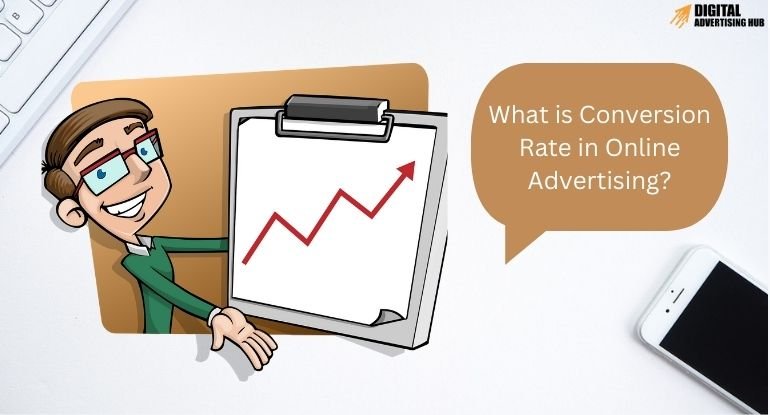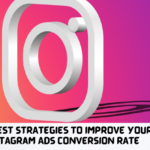In the dynamic world of online advertising, keeping a close eye on your campaign’s performance is very important. In our previous post, we explored the Return on Ad Spend (ROAS) metric, which helps us understand the financial return we’re getting on our advertising investment. Today, we’ll delve into another essential metric: Conversion Rate.
Conversion rate plays a central role in measuring the effectiveness of your online ads. It tells you the all-important story of how many people who see your ad actually take the desired action, whether it’s clicking through to your website, signing up for a free trial, or making a purchase.
By understanding and optimizing your conversion rate, you can ensure your ads are not just reaching the right audience, but also compelling them to take the next step and achieve your advertising goals.
What is Conversion Rate in Online Advertising?

Let’s break down the concept of conversion rate in the context of online advertising. In essence, it’s a percentage that tells you what proportion of users who see your ad actually take a specific action you define as a “conversion.”
These desired actions can vary depending on your campaign’s goals. Here are some common examples of conversions in online advertising:
#1. Clicks: When someone clicks on your ad and is directed to your website or landing page.
#2. Sign-ups: When someone completes a form on your landing page, subscribing to a newsletter, creating an account, or requesting a free trial.
#3. Downloads: When someone downloads a document, whitepaper, or other resource you’re offering through your ad.
#4. Purchases: When someone completes a purchase on your website after clicking on your ad.
The specific conversion you define for your campaign will depend on what stage of the customer journey you’re targeting. For instance, if you’re aiming to build brand awareness, clicks might be your primary conversion. However, for an e-commerce campaign, your primary conversion would likely be purchases.
Why is Conversion Rate Important?
Conversion rate isn’t just a vanity metric; it’s a critical compass for your online advertising success. Here’s why it deserves your close attention:
#1. Measures Ad Effectiveness: As mentioned before, conversion rate directly reflects how successful your ad is in driving desired actions. It goes beyond just clicks and impressions, revealing if your ad is truly converting curiosity into action.
#2. Identifies Areas for Improvement: A low conversion rate acts as a red flag, prompting you to diagnose the problem areas within your campaign. It could be anything from poorly targeted demographics to unclear ad copy or a confusing landing page. Analyzing conversion rate helps pinpoint these weaknesses, allowing you to optimize your campaign for better results.
#3. Maximizes ROI: As the saying goes, “What gets measured, gets managed.” Conversion rate helps you manage your advertising budget effectively. By understanding how well your ads are converting, you can allocate resources more efficiently. A high conversion rate signifies you’re getting more qualified leads or customers, leading to a higher return on your advertising investment.
#4. Informs Future Strategies: Conversion rate data is a goldmine for future campaigns. By analyzing past performance and what resonated with your audience, you can refine your targeting, messaging, and landing page design for even better results in the future.
#5. Provides Benchmarking Opportunities: Conversion rates can vary by industry, platform, and campaign goals. However, industry benchmarks can offer a helpful starting point. By comparing your conversion rate to these benchmarks, you can gauge your campaign’s relative performance and identify areas for improvement.
In essence, conversion rate is a powerful metric that provides a holistic view of your online advertising effectiveness. It helps you understand how well your ads are performing at every stage of the customer journey, identify areas for improvement, and ultimately maximize your return on investment.
How to Calculate Conversion Rate
Now that we understand the significance of conversion rate, let’s consider the practical side: how to calculate it. The formula itself is quite straightforward:
Conversion Rate = (Number of Conversions / Total Number of Interactions) x 100
Here’s a breakdown of the elements involved:
Number of Conversions: This refers to the total number of users who completed your desired action after seeing your ad. As mentioned earlier, this action can vary depending on your campaign goals (clicks, sign-ups, downloads, or purchases).
Total Number of Interactions: This depends on where you’re tracking conversions. If you’re focusing on website traffic driven by your ads, the total number of interactions might be the total ad impressions or clicks on your ad.
For instance, let’s say you’re running an online ad campaign promoting a free downloadable fitness guide. You see the following results in your analytics dashboard:
- Ad Impressions: 10,000
- Clicks to Landing Page: 500
- Free Guide Downloads: 100
Following the formula:
Conversion Rate = (100 Downloads / 500 Clicks) x 100 = 20%
This example translates to a 20% conversion rate, meaning 20% of users who clicked on your ad went on to download the free guide. By calculating your conversion rate, you gain a clear picture of how effective your ad is in driving the specific action you defined as a conversion.
Conversion Rate Benchmarks and What’s “Good”?

Alright, we’ve got the conversion rate formula down. But what constitutes a “good” conversion rate? The truth is, there’s no one-size-fits-all answer. Conversion rates can vary significantly depending on several factors:
#1. Industry: Different industries inherently have different conversion expectations. For instance, an e-commerce clothing store might see a healthy conversion rate at 2-3%, while a lead generation campaign for legal services might target a lower conversion rate of 1% or less.
#2. Advertising Platform: The platform where your ad is displayed can also influence conversion rates. Search network ads on Google typically have higher conversion rates compared to display network ads, as users on search are actively looking for solutions.
#3. Campaign Goals: As discussed earlier, the specific action you define as a conversion will impact the conversion rate. Targeting clicks will naturally yield a higher conversion rate than targeting purchases.
Here’s where industry benchmarks come in handy. These benchmarks offer a general range of what conversion rates are considered “average” within a particular industry or platform. Resources like WordStream or WebFX provide valuable data on conversion rate benchmarks.
However, it’s important to remember that benchmarks are just a starting point. Focusing on consistently improving your own conversion rate over time is more crucial than simply hitting a specific benchmark.
By analyzing your past performance and implementing optimization strategies, you can strive to outperform your own benchmarks and maximize the effectiveness of your online advertising efforts.
Tips to Improve Your Conversion Rate
Having a solid understanding of conversion rate and how to calculate it is just the first step. The real magic happens when you leverage this knowledge to optimize your campaigns and drive higher conversions. Here are some key strategies to consider:
#1. Landing Page Optimization: Your landing page plays a critical role in converting clicks into actions. Ensure your landing page is user-friendly, visually appealing, and clearly communicates the value proposition of your offer. Make sure it’s relevant to the ad that brought the user there and includes a strong call to action (CTA) that tells users exactly what you want them to do next.
#2. Ad Targeting Refinement: Scrutinize your targeting parameters to ensure you’re reaching the most relevant audience for your offer. Utilize demographics, interests, and behavioral targeting features offered by advertising platforms to attract users who are more likely to be interested in what you have to offer.
#3. A/B Testing is Your Friend: Don’t settle for assumptions! A/B testing allows you to experiment with different ad variations, including copy, visuals, and CTAs. By testing different elements and analyzing the results, you can identify what resonates best with your target audience and optimize your ads for higher conversion rates.
#4. Leverage the Power of Social Proof: Testimonials that Convert
In today’s digital landscape, social proof plays a crucial role in influencing user behavior. People are more likely to trust and engage with a brand or product that has positive feedback from real customers. Here’s how to leverage testimonials for conversion rate optimization:
- Showcase Customer Testimonials Strategically: Place testimonials prominently on your landing page, website, or within your ads themselves.
- Variety is Key: Feature testimonials from different customer segments to resonate with a broader audience. Include testimonials from customers with varying experience levels or challenges your product or service helped them overcome.
- Focus on Specific Benefits: Don’t just display generic praise; select testimonials that highlight the specific benefits and value your product or service offers. Let your customers’ words speak directly to the pain points and desires of your target audience.
- Authenticity Matters: Use real customer names, photos, and titles whenever possible to enhance the credibility and authenticity of your testimonials.
- Video Testimonials: Consider incorporating video testimonials where customers can share their experiences in a more personal and engaging way.
By strategically showcasing authentic customer testimonials, you build trust with potential customers, address their concerns, and ultimately nudge them towards taking the desired action on your landing page or ad.
#5. Offer Optimization: You’ve crafted a compelling ad, targeted the right audience, and directed them to a user-friendly landing page. But if your offer itself isn’t enticing enough, all your efforts might fall short. Here’s where offer optimization comes in.
What is offer optimization?
It’s the strategic process of tailoring your offer to resonate deeply with your target audience’s needs and desires, ultimately nudging them towards taking the desired action. This could involve:
#1. Understanding Your Audience: Before crafting your offer, conduct thorough audience research to understand their pain points, desires, and motivations. What keeps them up at night? What are their aspirations? By understanding your audience on a deeper level, you can tailor your offer to address their specific needs.
#2. Highlighting the Value Proposition: Clearly communicate the value your offer delivers. Don’t just list features; focus on the benefits your offer provides and how it will improve their lives. For example, instead of simply stating “Free Trial Available,” emphasize “Unlock 14 Days of Premium Features and Experience the Power of Our Software.”
#3. Scarcity and Urgency: People are naturally drawn to limited-time offers. Consider incorporating elements of scarcity or urgency to increase the perceived value of your offer. This could involve limited-time discounts, free bonuses with purchase for a short period, or early-bird access to a new product. However, be mindful of using these tactics ethically and avoid creating a sense of false urgency.
For instance, you’re selling athletic wear, instead of just offering a generic discount, you could target fitness enthusiasts by promoting a “Free Yoga Mat with Every Purchase Over $50” to incentivize conversions.
Perhaps,if you’re aiming to generate leads for a financial planning service, a free downloadable “Ultimate Guide to Retirement Planning” might be a more enticing offer than a generic e-book on personal finance.
By strategically optimizing your offer, you can significantly improve your conversion rates. Remember, it’s all about providing real value that resonates with your target audience and motivates them to take the next step.
By implementing these strategies and continuously monitoring your conversion rate, you can gain valuable insights into what’s working and what’s not in your online advertising campaigns. Remember, conversion rate optimization is an ongoing process. By consistently testing, refining, and improving your approach, you can unlock the full potential of your online advertising efforts and achieve your marketing goals.
Conclusion
In closing, conversion rate isn’t just a number; it’s the compass that guides your online advertising efforts towards success. It tells the story of how effectively your ads are converting interest into action, ultimately driving the results you desire. By understanding and tracking your conversion rate, you gain valuable insights into your campaign’s performance and identify areas for improvement.
Here’s the key takeaway: Don’t just track your conversion rate, analyze it! Dive deeper into the data to understand what resonates with your audience and what roadblocks might be hindering conversions.
Implement the optimization strategies we discussed, like crafting compelling landing pages, refining your ad targeting, embracing A/B testing, and optimizing your offer for maximum value. Remember, conversion rate optimization is a continuous journey.
By consistently monitoring your results, testing different approaches, and refining your campaigns, you can unlock the full potential of your online advertising and achieve lasting success. So, go forth, analyze, optimize, and watch your conversion rates soar!










